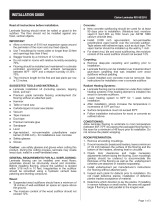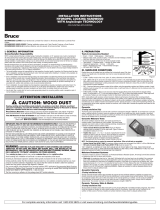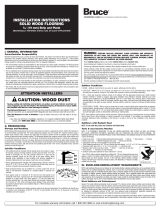Page is loading ...

LAMINATE INSTALLATION/MAINTENANCE TIP SHEET
Product: Laminate Use: Commercial
INSTALLATION
TYPES OF SUBFLOORS ■ Concrete ■ Wood Flooring
■ Wood Subfloors ■ Ceramic and Resilient Tile
■ Underlayment Boards ■ Vinyl Sheet
INSTALLATION Angle/Angle
■ Roll out Armstrong
®
Underlayment. Begin at starting wall and work out.
■ Lay first row of planks with tongue side facing the wall. Angle the short end to lock planks
together. If the starting wall is crooked, trace the contour of the wall. Use spacers along all
sides that butt up against walls to maintain 1/4˝ – 1/2˝ (6.35 – 12.7 mm) expansion zone.
■ Install remaining rows and stagger end joints at least 8˝ apart. (1) Install long end of first
plank in second row at an angle. Keep plank angled slightly off subfloor. Use a scrap piece
of laminate to support the row. (2) Angle end joint of second plank into the first plank and
overlap the groove of planks in first row. (3) Angle up and push forward until the planks lock
together. (4) After all planks in each row are installed, press planks flat to underlayment to
lock into place.
■ Finish with trim or moulding. Remove spacers. Predrill trim or moulding prior to nailing.
Do not fasten directly to the floor to allow for expansion.
■ T-mouldings must be used between rooms or in areas where the room is larger than
80´ (24.38 m) across plank length or wider than 52´ (15.85 m) across plank width.
Lock&Fold
®
■ Roll out Armstrong
®
Underlayment. Begin at starting wall and work out.
■ Lay first row of planks with tongue side facing the wall. If plank contains plastic insert in
groove of short side, push together until planks snap into place. If the starting wall is
crooked, trace the contour of the wall. Use spacers along all sides that butt up against walls
to maintain 1/4˝ – 1/2˝ (6.35 – 12.7 mm) expansion zone.
■ Install remaining rows and stagger end joints at least 8˝ apart. (1) Install long end of each
plank at a downward angle to planks in previous row. Short end should overlap groove of
plank in
same row. (2) Press down flat to underlayment to lock into place. If plank contains
plastic insert, press down until planks snap together.
■ Finish with trim or moulding. Remove spacers. Predrill trim or moulding prior to nailing.
Do not fasten directly to the floor to allow for expansion.
■ T-mouldings must be used between rooms or in areas where the room is larger than
80´ (24.38 m) across plank length or wider than 52´ (15.85 m) across plank width.

■ Armstrong
®
Laminate Flooring may be installed in bathrooms following the guidelines
outlined in the Bathroom Installation Section in the F-5061 manual.
■ Armstrong Laminate Flooring is not recommended over most carpets or in high-humidity
areas where the floor is normally wet - e.g., steam rooms or saunas.
■ The slope should not exceed 1˝ in 6´ (2.54 cm in 1.83 m).
■ Variations in subfloor flatness should not exceed 3/16˝ in 10´ (4.76 mm in 3.05 m) or 1/8˝
in 6´ (3.17 mm in 1.83 m). Level floors with a suitable cement-based self-leveling
underlayment following the manufacturer's recommended guidelines
■ Radiant heated subfloors should not exceed 85º F (29º C).
■ All substrates must meet applicable building codes, be structurally sound, show minimal
deflection, be dry, clean and flat.
■ The room temperature should be at a minimum of 65° F (18° C) for 48 hours before, during,
and 48 hours after installation.
■ Armstrong Laminate floors do not require acclimation.
■ During and after installation, the room temperature should not exceed a maximum of
100° F (38° C).
■ Install parallel to incoming light from any windows, or if lighting is not a concern, parallel to
the longest wall in the room.
■ It is a good idea to use 100% silicone caulk in areas of rooms where excessive moisture
may be present, such as at kitchen sinks, dishwashers and ice makers. See Bathroom
Installation section for instructions on Full Bathroom Installations in the F-5061 manual.
Install cabinets then install the laminate around the cabinets leaving the 1/4˝ (6.35 mm) to
1/2˝ (12.7 mm) expansion zone.
■ If installing cabinets after the laminate has been installed, most or all of the cabinet weight
should be supported by the wall mountings. To secure the cabinets to the substrate with
screws or nails, drill holes through the laminate 1/2˝ (12.7 mm) in diameter larger than the
screw or nail to allow for expansion.
■ When installing an island, it must be freestanding and weigh less than 250 pounds if it is to
be installed over the laminate.
■ If the island weighs more than 250 pounds, the laminate is to be installed around the island
allowing the normal 1/4˝ (6.35 mm) to 1/2˝ (12.7 mm) in expansion area around the base of
the island.
■ If the laminate has already been installed, and the island must be installed over the laminate,
and the island weighs more than the 250 lbs maximum, drill holes through the laminate
1/2˝ (12.7 mm) in diameter larger than the bolts (to allow for expansion) and bolt the island
to the subfloor.
SPECIAL PRECAUTIONS
AND RECOMMENDATIONS

CARE INSTRUCTIONS ■ Armstrong
®
Laminate Flooring is extremely easy to clean.
■ DO NOT WAX OR POLISH your floor.
■ For everyday cleaning, vacuum with a wand attachment or damp mop.
■ To remove excessive dirt buildup, use Armstrong Hardwood & Laminate Floor Cleaner (S-302).
■ Before using water, or Armstrong Hardwood & Laminate Floor Cleaner (S-302), thoroughly
wring out your mop or sponge. An excessive amount of moisture is not necessary.
■ As with any hard-surface material, laminate flooring can be slippery when wet.
Promptly wipe up spills with a moist sponge or soft cloth.
■ DO NOT CLEAN THIS FLOOR WITH ABRASIVE CLEANSERS, ABRASIVE SCRUBBING PADS,
STEEL WOOL, OR SCOURING POWDER.
■ To avoid scratching, use Armstrong Floor Protectors or protective pads under chairs and
furniture legs.
■ Use walk-off mats at entryways to collect tracked-in dirt and grit and to absorb excess
moisture.
■ Because metal rolling casters can damage the floor, we do not recommend them. If rolling
casters are used, we recommend only soft wheels wide enough to support the load.
LF-1404-309 © 2009 AWI Licensing Company Printed in United States of America.
Armstrong
®
and Lock&Fold
®
are registered in the United States only.
/




